NORTH WALES COAST RAILWAY :NOTICE BOARD
Rheilffordd arfordir gogledd Cymru: Hysbysfwrdd
17 July 2023




Contributions to the Notice Board are welcome, although they may not always be used, due to time constraints, especially if they don't follow the file name convention given on the Contributions Page.
Forthcoming events
Charter trains, and meetings, may be subject to cancellation or postponement. See our Calendar Page for Club and Society details.
August 2023
September 2023
Friday 1 September
Clwyd Railway Circle A History of The Internal Railway at Shotton Steelworks and its Links with the Main Line. Glyn Jones
Wednesday 13 September Statesman Rail The Snowdonia Statesman High Wycombe IST Birmingham NS - Betws-y-coed/Blaenau Ffestiniog LSL Pullman
16-17 September : Bala Model Show Ysgol Godre'r Berwyn School, Ffrydan Road, Bala, Gwynedd LL23 7RU
10.00-16.00 both days
Approximately 20 layouts, half standard gauge, half narrow (including live steam).
October 2023
Friday 6 October Clwyd Railway Circle A Year in the Life of an International Train Spotter - Part 2. Phil Thomas
11 October Statesman Rail The Snowdonia Statesman Stevenage - Nuneaton - Betws-y-coed /Blaenau Ffestiniog LSL Pullman
November 2023
Friday 3 November Clwyd Railway Circle The Railway in Conway. Larry Davies
December 2023
Friday 1 December Clwyd Railway Circle Members Night Presentations. Members are invited to give a 15-minute presentation of their choice.
(see our Calendar page for meeting venues)
North Wales Coast Railway website created and compiled by Charlie Hulme
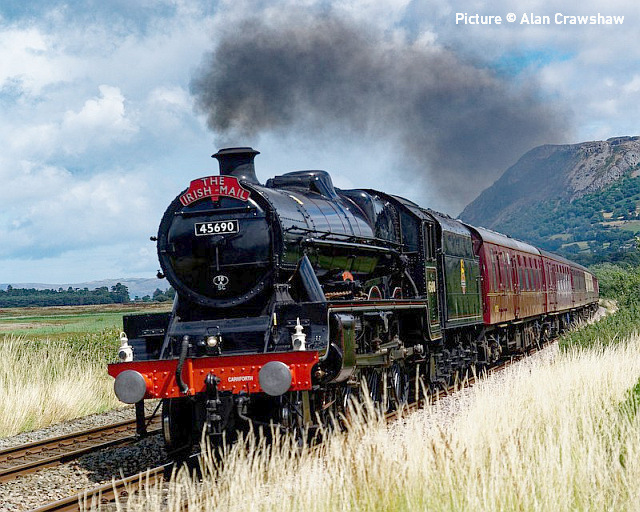
The North Wales Coast Express a.k.a The Irish Mail, passes Pentre Du, 16 July. More pictures below. Picture by Alan Crawshaw.
News pictures
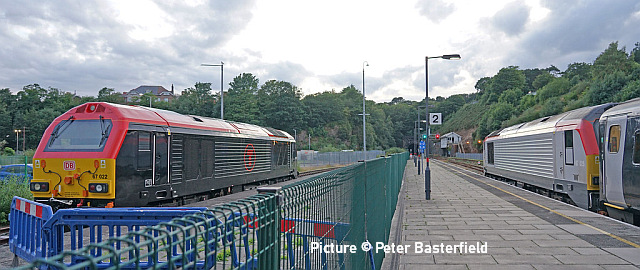
Two 67s meet at Bangor on Tuesday night 11 July. After over two months 'stabled' in the bay platform, 67 022 left at 21:30 as 0Z22 for Basford Hall, reached at 00:58, 97 minutes late on its planned trip. Under its own power it took an hour to get to Llandudno Junction. A driver must have arrived by the Cardiff - Holyhead 'Wag', hauled by 67 025. (Peter Basterfield).
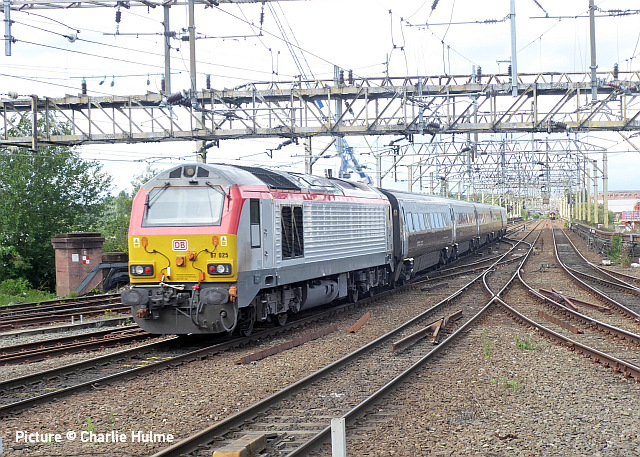
The following day, 12 July, 67 025 was captured propelling the 10:52 Cardiff - Manchester out of Stockport, 9 minutes late. This will form the 14:30 Manchester - Cardiff (Charlie Hulme).
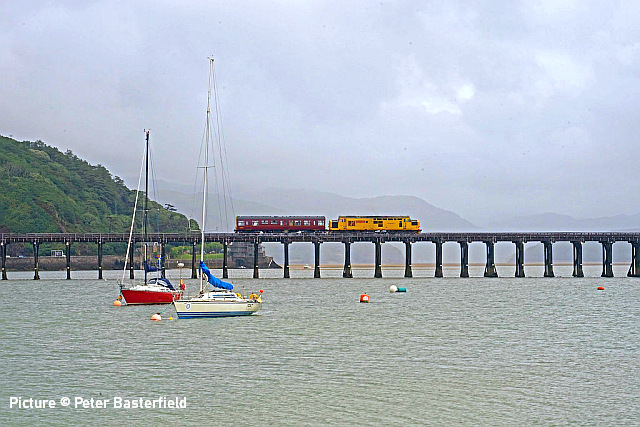
At the other end of the route (Shrewsbury - Barmouth) we mentioned last time, 97 302 crosses Barmouth Bridge on 11 July on Cambrian learning experience for the 'YRP (Young Railway Professionals) provided by the East Coast Digital Programme. This ran on four days
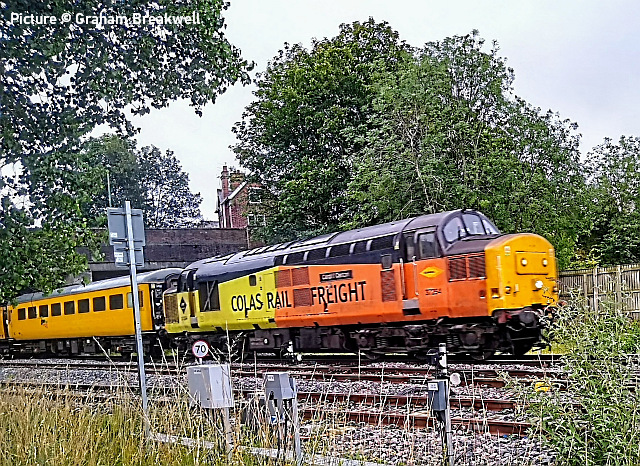
37 254 passes Abbey Foregate signalbox, Shewsbury on 14 July on a Netwrok Rail train, 12:55 from Derby RTC round trip, turning back at Wrexham ...
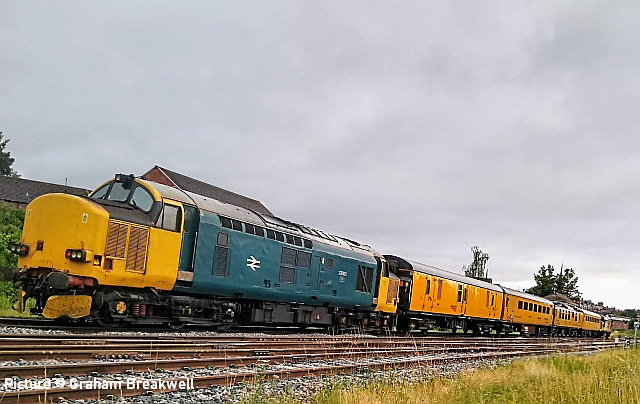
... 37 610 on the rear (Graham Breakwell).
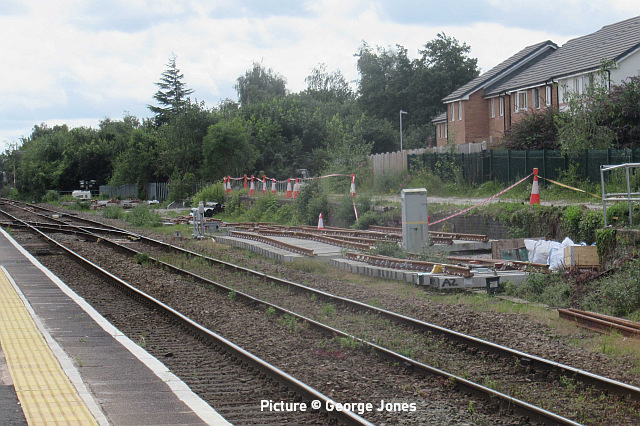
George Jones writes: Track panels now in place at lineside ready for the forthcoming renewals. Notices are posted for line closures Chester to Shrewsbury and Wrexham to Bidston on 22/23 and 29/30 July with bus replacement services.
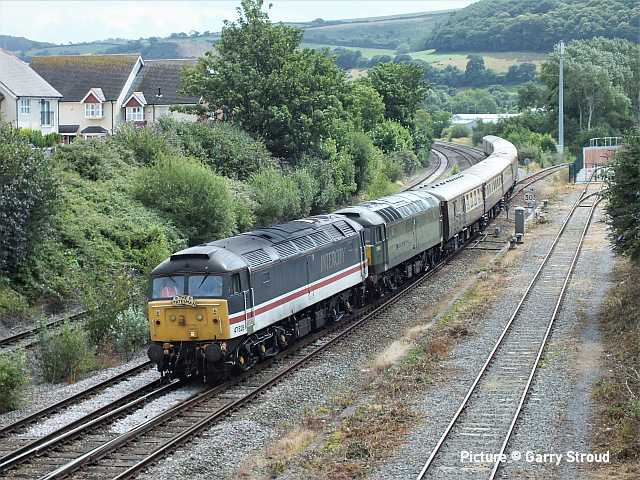
Two views of the 1Z47 05:15 Kilmarnock to Blaenau Ffestiniog Statesman tour, Wednesday 12 July. 47 828 and 47 810 enter Llandudno Junction en route to Blaenau Ffestiniog.
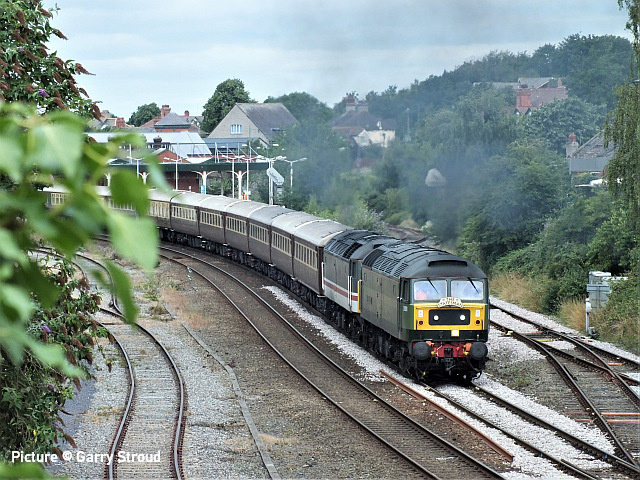
After reversal 47 810 leads 47 828 as they make a smoky departure from
Llandudno Jcn en route to Blaenau.
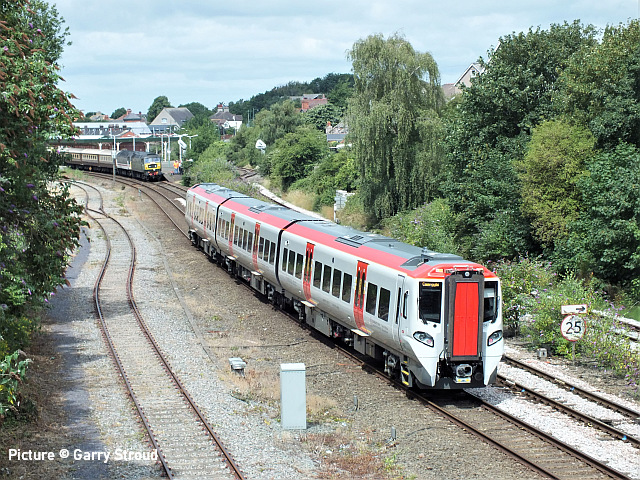
Gradually the 3- car Class 197s are starting to appear along
the coast, this view at Llandudno Junction on 12 July 1T34 10-55 Chester to Holyhead service, replacing a cancelled Manchester Airport - Holyhead service (Garry Stroud).
Leander on the Coast
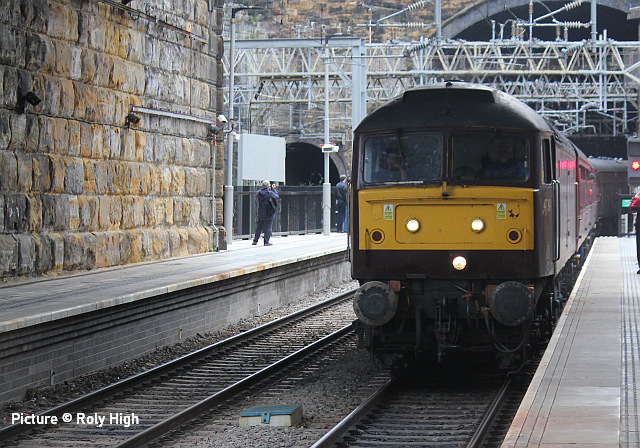
The "North Wales Coast Express" was an excursion from Liverpool Lime Street - Holyhead and return on Sunday 16th July. Above, 47 804 brings the empty stock from Crewe with Leander on the rear into Liverpool Lime Street to form 1Z50 to Holyhead.The 47 will detach here and stable in Edge Hill Sidings leaving Leander to take the train to Holyhead; on its return, the 47 will take the coaches back to Carnforth (Roly High).
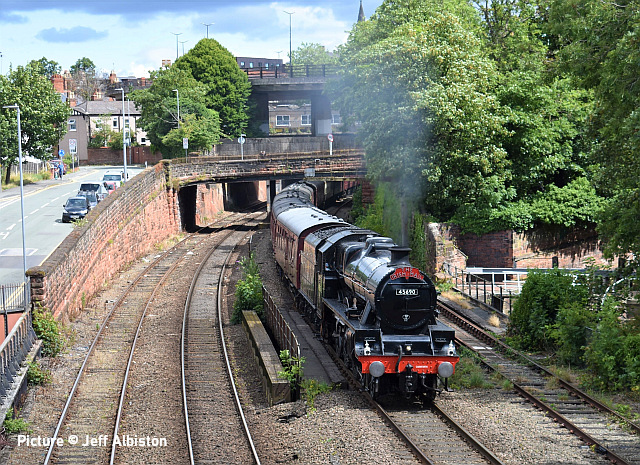
Chester walls (Jeff Albiston).
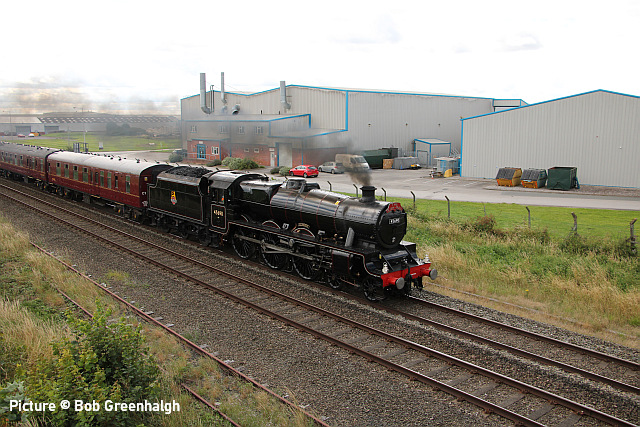
Beeches Farm (Bob Greenalgh).
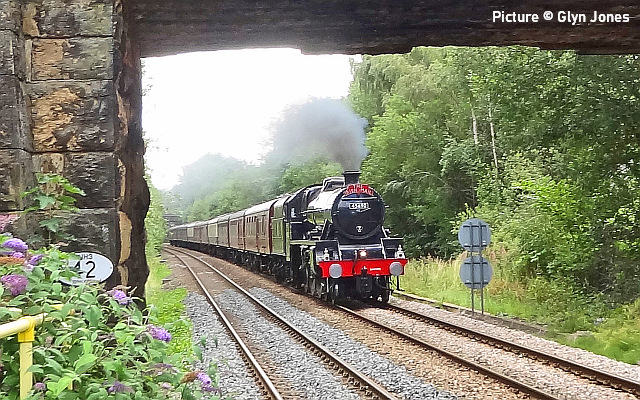
Flint (Glyn Jones).
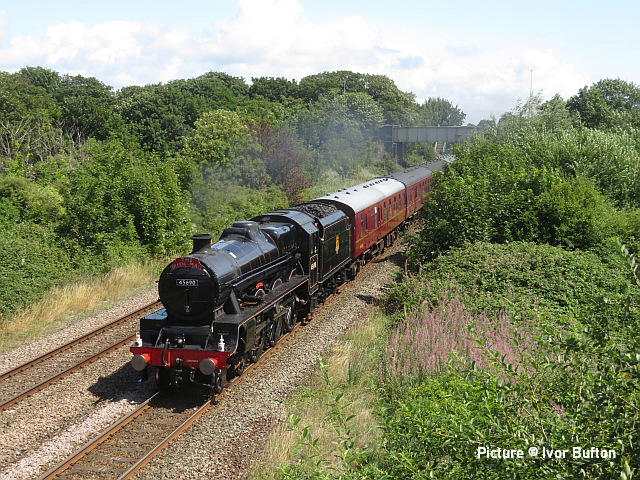
Prestatyn (Ivor Bufton)
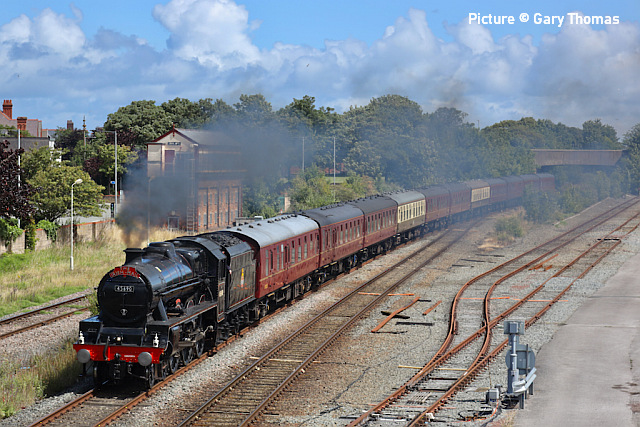
Rhyl (Gary Thomas)
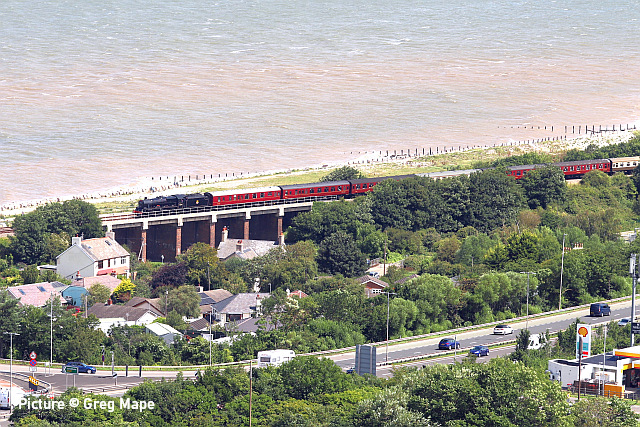
Llandulas Viaduct (Greg Mape)
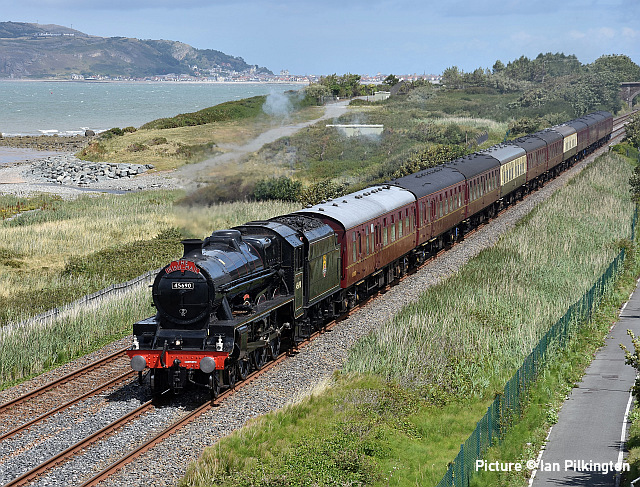
After the Llandudno Junction water stop, 45690 passes Dwygyfylchi. (Ian Pilkington)
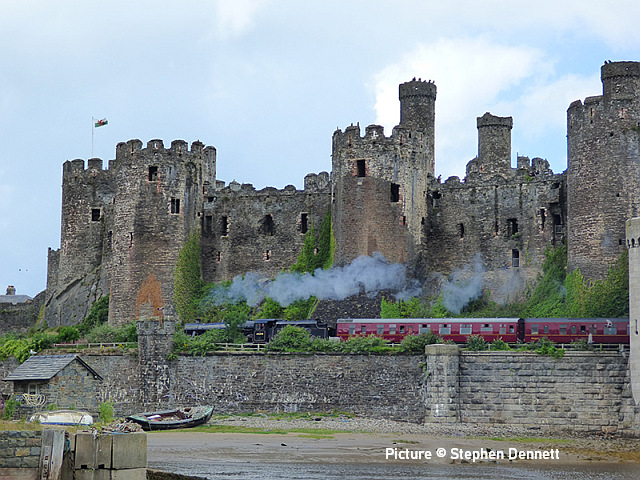
Conwy (Stephen Dennett).
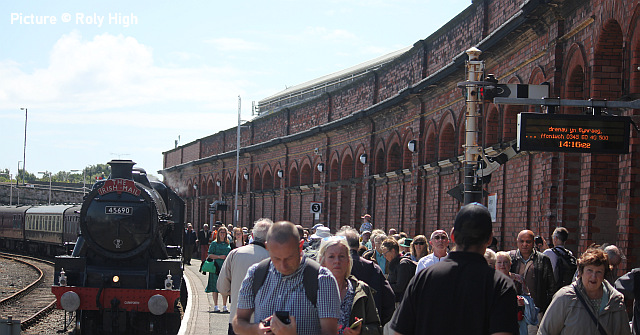
After arrival at Holyhead, Leander gets the signal to draw forward over the release points to head for the Valley triangle (Roly High).
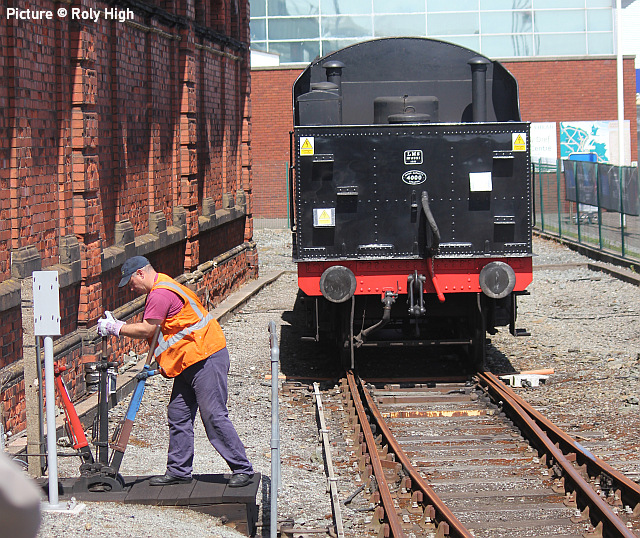
The ground frame in operation: not a common sight in recent years as the rust on the rails testifies.
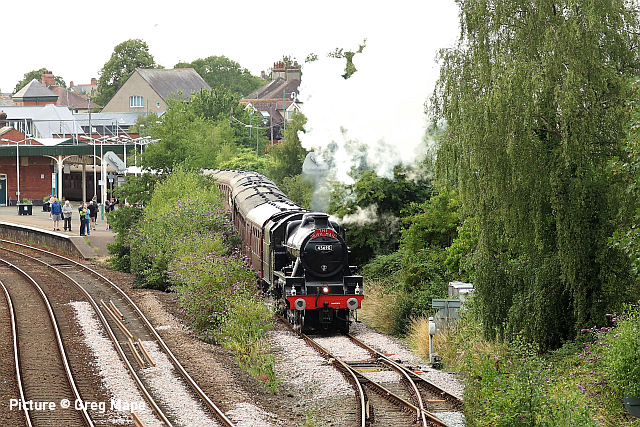
Departure from Llandudno Junction (Greg Mape).
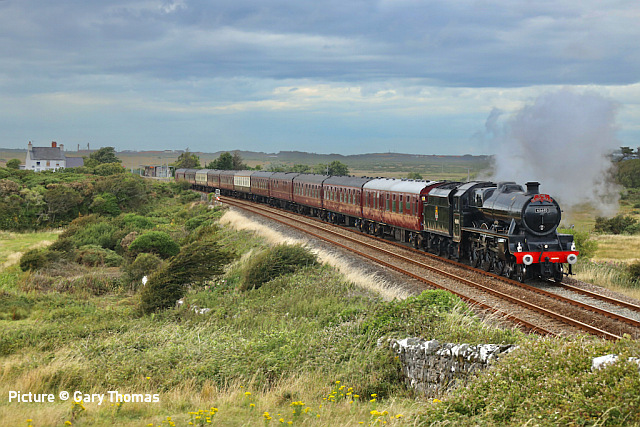
Rhosneigr (Gary Thomas).
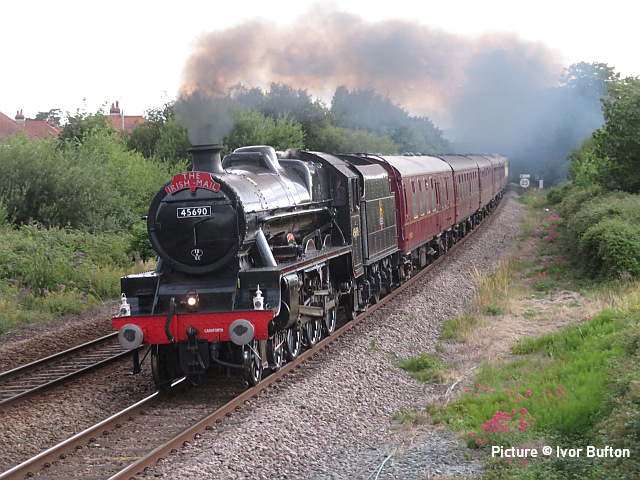
Rhyl (Ivor Bufton).
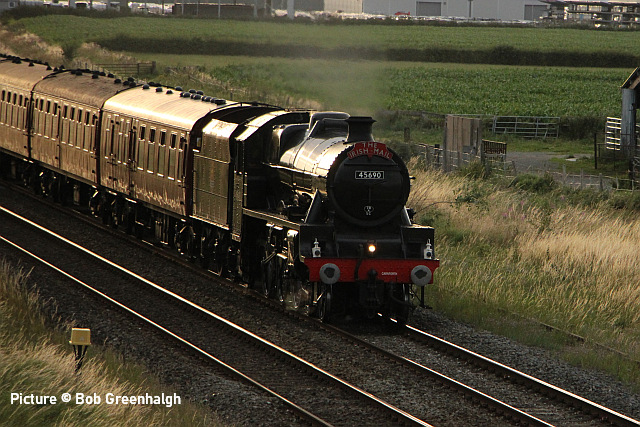
Beeches Farm (Bob Greenhalgh).
Royal Scot
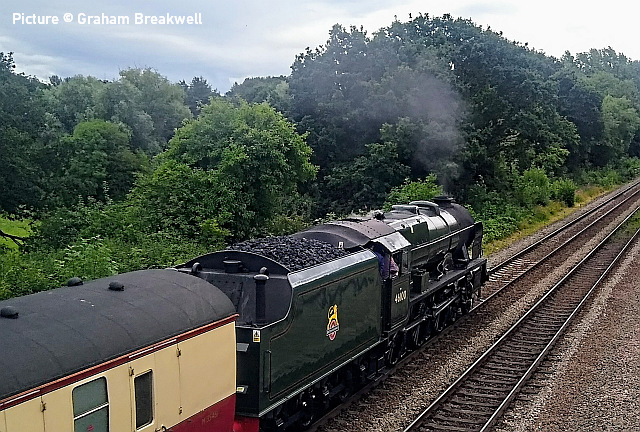
46100 Royal Scot working hard with 1Z52, the returning Locomotive Services Slough to Shrewsbury on 13 July. D1935 (47805) “Roger Hosking MA 1925-2013 “ was on the tail. (Graham Breakwell)
Shrewsbury scenes - by Graham Breakwell
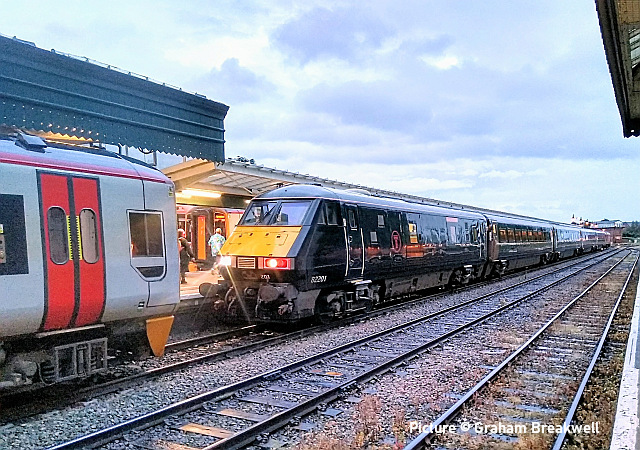
Two images from Shrewsbury’s platform 3, a scene of confusion on 15 July when large crowds were making their way home from the “Let’s Rock” event on the town's park. Late running of 1W65, with 88201 leading and 67 010 on the rear of the 18:55 Cardiff to Manchester created havoc on Platform 4 when it had to pull up behind the 5J72 Shrewsbury to Chester ECS. The knock-on effect resulted in the Aberystwyth to Birmingham New Street being diverted to platform 3 and turning into the 21:43 back to Aberystwyth whilst the Birmingham International to Aberystwyth turned back to become the 21:32 back to Birmingham from Platform 5.
Changing from the main platforms to platform 3 for the Aberystwyth service means going downstairs, out through the barriers, across the station frontage and back up stairs again, a lot of unhappy travellers, especially when the incoming driver and conductor were not sure what was happening next and the information screens were showing two coaches despite the train being four. It left as a four coach still displaying Birmingham New Streer as the destination!
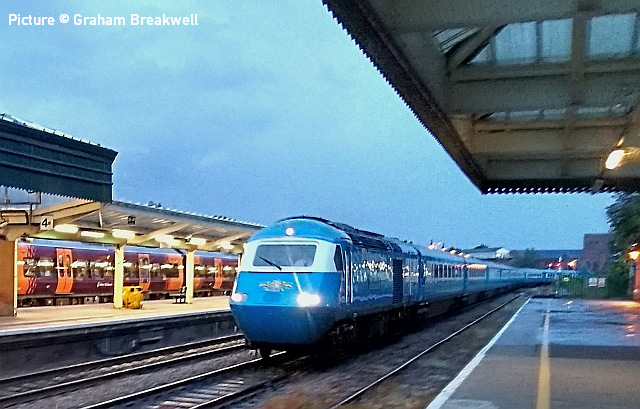
Meanwhile, with light fading and grey skies the Midland Pullman slipped past on the down main line with 1Z44, the return run of the Locomotive Services long distance excursion from Ulverston to Paignton. Late running of 1W65 meant the Pullman had to follow the Manchester-bound TfW service making it 30 minutes late at Shrewsbury.
From Dave Sallery's archive
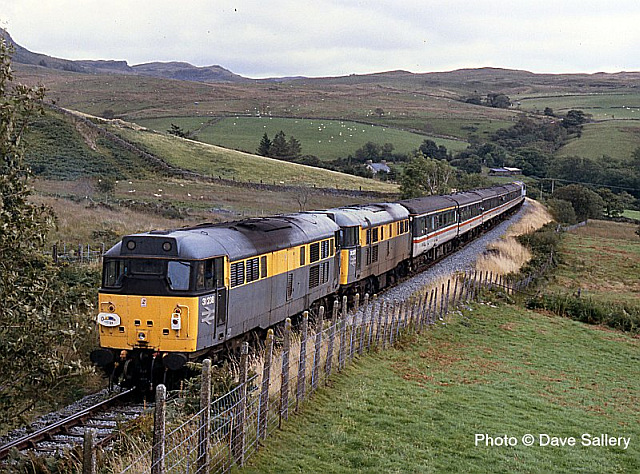
31 238 and 31 207 at Cwm Teigl near Ffestiniog, 10 September 1994. The pair were on the front of the second Trawsfynydd Trekker with 20 075 and 20 187 on the rear.
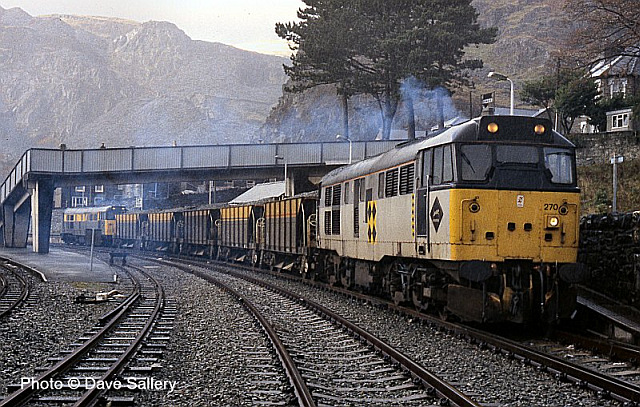
31270 and 31 242 in Blaenau on 14 November 1993 ready to drop ballast on the Trawsfynydd branch.
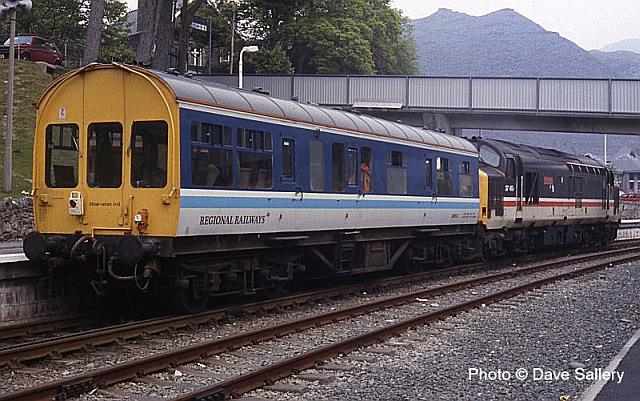
37 407 and a Regional Railways inspection saloon in Blaenau, 13 May 1993.
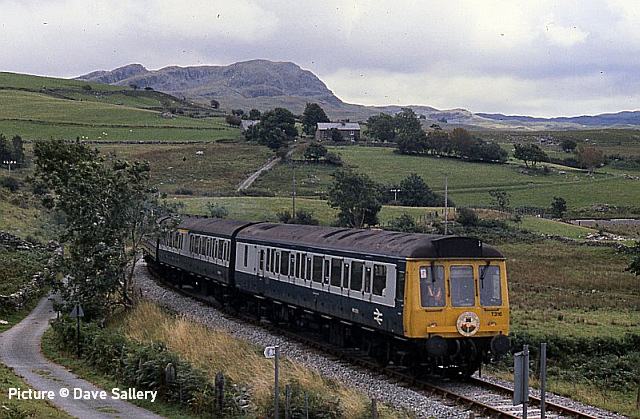
Diesel Multiple Unit T316 on the Trawsfynydd branch near Manod with a service to Trawsfynydd. These trains were an extension of the 'Conwy Valley Sunday Shuttles'. Alighting at Trawsfynydd was not permitted. 2 September 1990.
Looking back: Pioneer Class 37s - by David Pool
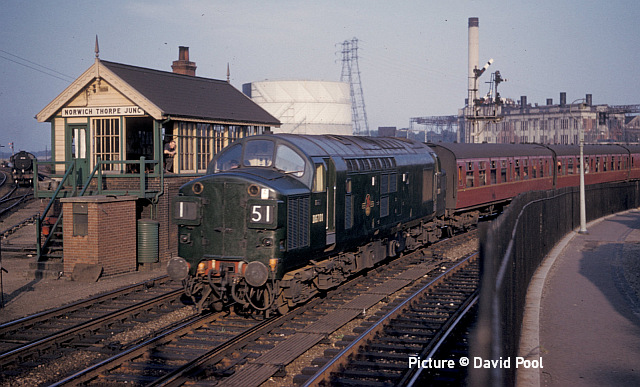
In 1961 Class 37 locomotives built in English Electric’s Vulcan Foundry were beginning to appear, and the second locomotive of the Class, D6701, was photographed at Norwich Thorpe, arriving with the 16:30 departure for Liverpool Street. This had been delivered in December 1960, before the era of yellow front ends. The double doors which in theory might be used as connections between locomotives are clearly seen. I am not aware of any regular use of these doors, which apparently were not very weatherproof, and eventually were plated over.
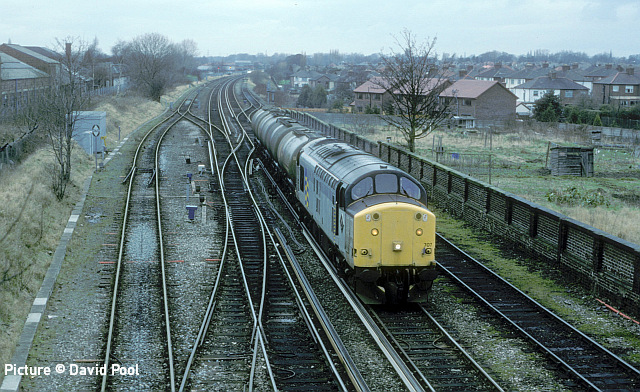
D6701 became 37 001 under the TOPS system, and in 1987 was renumbered 37 707, after it had been refurbished with an alternator instead of a generator and fitted with additional weights to improve adhesion. In 1994 it was in Railfreight Petroleum livery, working the Saturdays only 1328 Stanlow to Holyhead on 5 February. It has passed through Bache, and is approaching Chester North Junction.
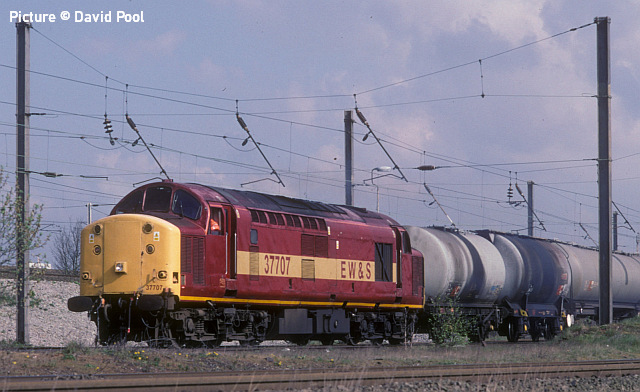
On 19 April 2002 37 707 was in the first EW&S livery, and was leaving Warrington Arpley with the 1003 to Sandbach freight. In 2011 it was withdrawn and scrapped.
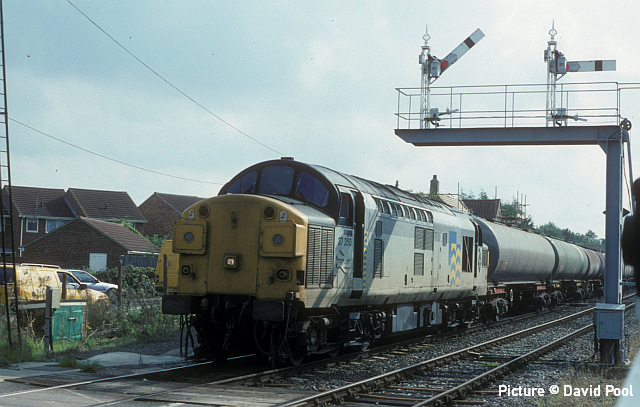
I never saw the first Class 37 in BR days as D6700. The TOPS system would not accept 37 000, so it became 37 119, and later 37 350 when it received CP7 bogies. Although it had been repainted as D6700 in green with full yellow ends in 1988, it was 37 350 in Railfreight Petroleum livery on the Fawley branch in Hampshire on 29 September 1992, and is shown at Marchwood. The shot over the level crossing gates was not ideal, but I wanted to show the signal. The train was on the platform side of the passing loop, which helped. A later shot at Redbridge on the main line was more conventional but less interesting!
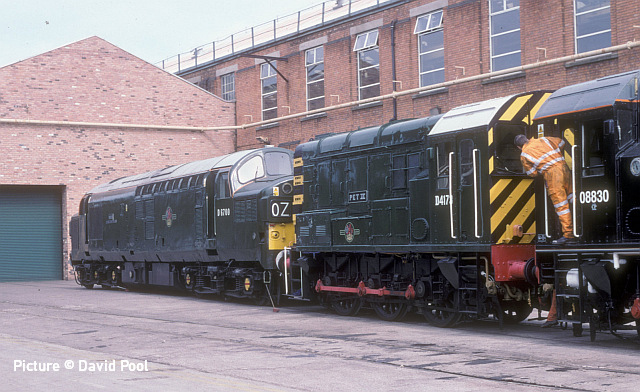
At Toton in 1998 it was again repainted as D6700 in green, this time without the yellow end panels, later receiving the name NRM National Railway Museum. It was withdrawn from service in 2001, and became part of NRM’s National Collection. Appearing at the Crewe open day on 1 June 2003 it was in green, but now with small yellow panels on the ends, as illustrated in the image in the Notice Board of 3 May 2022. On that occasion it had been moved into position by the shunter 08 830 (now preserved as D3998 at Peak Rail) accompanied by D4173 Pet II (08 943).
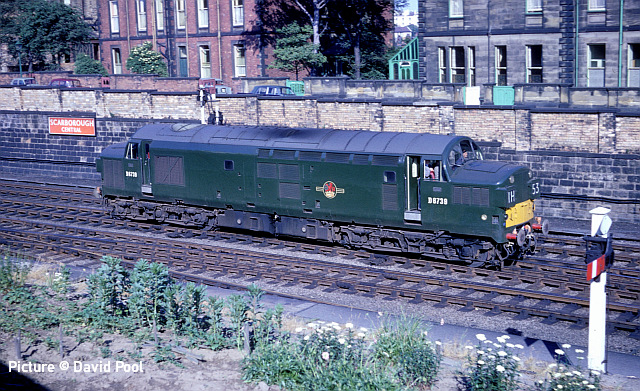
Another early example of a Class 37 was D6739, which I photographed at Scarborough on 17 July 1962. By then the small yellow panels had been applied.
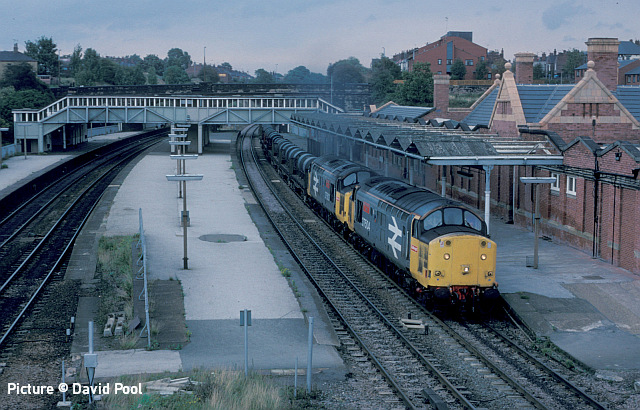
This became 37 039 and worked mostly in East Anglia up to 1981, when it was transferred to Scotland, staying there until 1985, when it received a Heavy General Overhaul at Crewe in 1986, being then renumbered 37 504. On 27 September 1988 37 504 British Steel Corby was paired with 37 503 British Steel Shelton on a working through Rotherham Masborough, not surprisingly conveying steel coils.
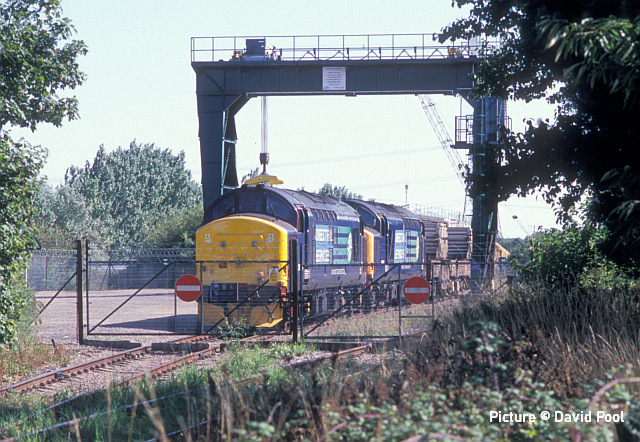
The next identity for 37 504 was in 1996, when it was transferred to the European Passenger Services fleet as 37 603. With changing plans for their use with EPS, the Class 37/6s were occasionally seen on other duties, as illustrated in the NWCR News issue of 21 February 2022, transferring next to the Direct Rail Services fleet. 37 603 was often seen on the Valley Flasks, but on 28 August 2013 it was visiting East Anglia, being photographed at Sizewell behind 37 405. It left at 1542 on 6M69 to Willesden, where the flasks from Dungeness may have been added before heading North to Sellafield. Now surplus to the requirements of DRS, 37 603 has recently been acquired by Harry Needle.
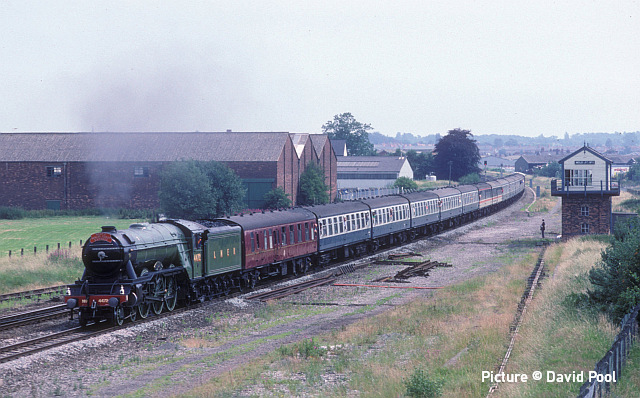
On 15 July 1990 4472 Flying Scotsman made a visit to the North Wales coast, being photographed at Mold Junction.
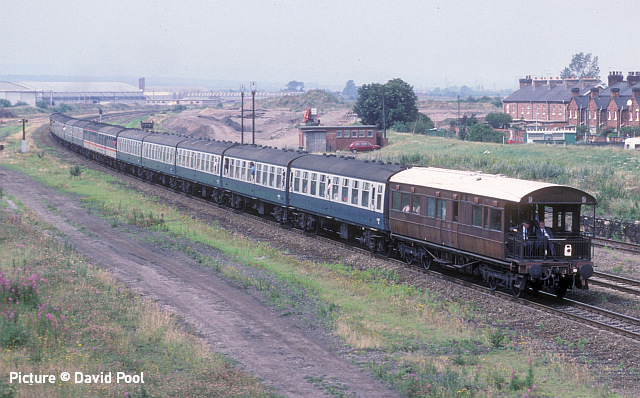
At the rear of the train was a saloon with an open verandah. It is Great Eastern Railway No.1, the General Manager's Saloon built in 1920. Fitted with Gresley bogies in 1934, it was used by British Railways until 1971, and then sold to 'Flying Scotsman Enterprises' who had it fully restored and fitted with air and vacuum braking, and steam and electrical train heating for use on charter and excursion trains. Latterly it was stabled at Sir William McAlpine's Fawley Hill railway.
Thoughts on coal traffic - by Mark Hambly
Regarding the query arising from David Pool's photo of 56 127 on an Merry-go-round train at Halwhistle, it may well be that it was conveying coal from Plenmeller opencast site, for which the loading point was a long loop on the south side of the Tyne Valley line a little way to the east of Haltwhistle. If so it was fairly soon after the site opened. For a brief description see Plenmeller Opencast Mine (1991 - 2002) at co-curate/ncl.ac.uk.
As to where the coal then went I'm afraid I don't know. If for power generation (which much of UK coal output of course was at the time) then, unless the move westwards towards Carlisle was simply to reach a suitable point to run round the train before heading back east to somewhere like Lynemouth or Blyth, I suppose that from Carlisle it may perhaps have headed south on the WCML to eventually reach Fiddlers Ferry via Warrington or over the Settle and Carlisle to one of the Aire Valley stations via Healey Mills.
Incidentally, also, regarding the train from Wych Farm headed by 60 026, the commodity being conveyed on this occasion is gas rather than oil, as evidenced by the livery of the tanks (white with horizontal orange stripe). Both oil and gas were transported by rail from Wych Farm during the period the rail terminal there was operational.
TV star corner
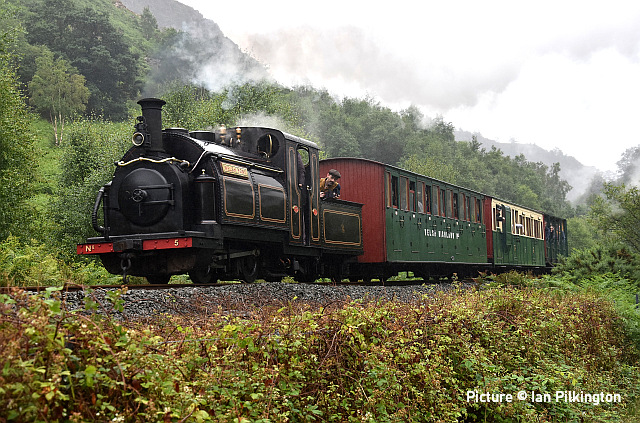
Jack Bowley writes to tell us that the person seen in the tender of Welsh Pony in the last issue was Tim Dunn, maker of TV railway programmes, who was doing some filming around the event.
North Wales Coast home page | Archive | Previous Notice Board